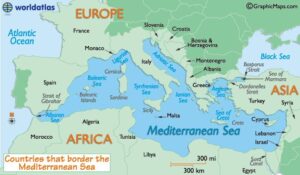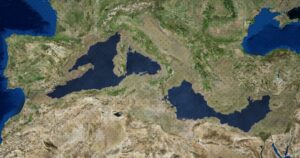The Mediterranean Sea is well-known for its blue waters and breathtakingly beautiful coasts and islands. The tourism in the area is expected to hit 650 million visitors by 2050 and it is considered to be one of the most beautiful destination by millions of tourists.

Source: GraphicMaps.com
However, what is now a wonderful sea used to be land millions of years ago as almost all the water dried up.
That’s exactly right. There was a time when the Mediterranean Sea ceased to exist and Africa was linked to Europe by land allowing several animals to freely roam back and forth between the two continents.

Source: University of Malta
How that happened? How is it even possible? How can a sea as large as the Mediterranean dry up?
Well, let’s dive into it (pun intended).
In 2011 some paleontologists working in Menorca, the Spanish island, discovered the bones of a really big (but really big) rabbit. After doing some research, scientists estimated this creature was 6 times bigger and heavier than current rabbits and that is why they call it the Rabbit King of Menorca, which apparently lived around 5 million years ago.
The Rabbit king of Menorca is a clear case of insular gigantism, which is a well-known phenomenon where small animals that become isolated on an island overgrow into a larger form of themselves because of a lack of natural predators.
What does this big, fluffy rabbit have anything to do with the Mediterranean Sea?

Source: nature.com
Well, scientists were baffled as to how the normal-sized rabbit managed to arrive on the island of Menorca given that the island is located 246 km away in the sea (152.8 miles) from Barcelona.
How did the normal rabbit arrive there?
In order to explain this, we need to take a step back, shall we?
The floor of the Mediterranean Sea is made of several layers. Most of these layers are made of mud and sand (which are the usual materials found also in other seas). However, what makes the Mediterranean Sea so unique are enormous deposits of salt. Underneath the sea bed there a lot of layers which consists of thick deposits of salt crystals.
These deposits are so big, they are so large that scientists call them the “Mediterranean Salt Giant.”

Source: www.saltgiant-etn.com
These salty giants, however, are a sign that, at some point in history, the Mediterranean Sea must have dried up almost completely. In other words, the Mediterranean Sea must have evaporated almost completely leaving only salt crystals on the sea bed.
The mystery puzzled researchers and scientists for quite a while and a few theories have been proposed to explain this phenomenon but the definite answer was found thanks to some geological studies.
Do you want to know what the right answer was? Well, jump to the second part of this exciting article!